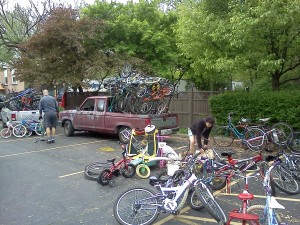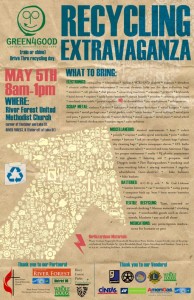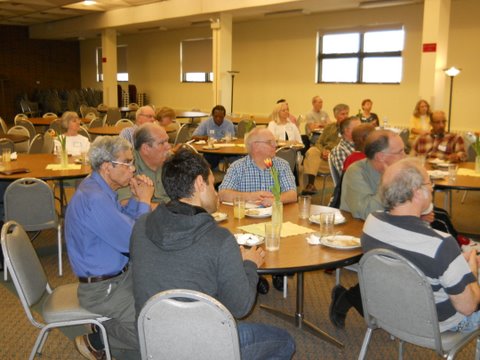 Submitted by James Babcock
Submitted by James Babcock
Affordable and Accessible Home Energy Efficiency Program
The Interfaith Green Network is continuing to ramp up efforts to implement the goals of the PlanItGreen sustainability plan for OP/RF by bringing actionable strategies to local congregations and households.
To that end, four Interfaith Green Network members, representing Oak Park congregations, along with 15 other Chicagoland residents recently met at the offices of Center for Neighborhood Technology (CNT) for an in-depth briefing and training session about the energy efficiency program, Energy Impact Illinois (EI-2). The goal of the initiative is to bring the program directly to community residents so that homeowners are informed about this affordable and very accessible way to reduce their carbon footprint, make their homes more comfortable and more valuable, and save money at the same time!
Essential Components:
As explained by Anna Markowski of CNT, Energy Impact Illinois is for single-family residences, condo’s, and buildings with four or less units. The essential components of the program are as follows:
Accredited Work Force: All participating contractors are certified by the Building Performance Institute (BPI). In addition, CNT has vetted each contractor by observing at least five of their work sites to see that they meet construction standards. CNT will continue to inspect a percentage of the work sites as the program grows.
Incentives: Energy auditors are currently offering an initial energy assessment for only $99. This assessment includes a blower-door test, thermal imaging, and a combustion safety test of your furnace/boiler equipment. Typically, the cost for such an assessment is $350-$800 depending on the size of your house. The assessment report will include a recommended retrofit plan, including associated costs and the estimated energy savings. The homeowner can choose from these recommendations the strategies that they wish to implement at this time.
Financing: Unsecured loans from participating local lenders are available to applicants who wish to avoid the upfront cost of energy efficiency retrofits. For the first building in Oak Park to participate in the program, the owners found that the loan cost was less than the monthly energy savings after construction was completed. (Nationally, investments in the energy efficiency of buildings have realized, over the last 20 years, some of the best rates-of-return available anywhere!)
Great return on investment plus increased home value
The bulk of home energy efficiency can be accomplished by air sealing (plugging leaks in the “building envelope”) and by adding insulation to attics and walls. To qualify for the program, homeowners must agree to retrofits that accomplish a minimum of 15% increased efficiency. According to Markowski, because of the nature of the housing stock in the Chicago area, 98-99% of our houses can attain this added efficiency fairly easily—even new construction! Homeowners who want to replace old furnaces or boilers with high efficiency units, automatically qualify for Energy Impact Illinois.
Homeowners who look forward to selling their homes in the future should know that the local Multiple Listings Service now officially recognizes green homes. This is a recent development. Bonnie Marx of Green Energy Improvements reports that in other locales, homes with such listings have been appraising about $20 higher for every dollar in annual energy cost savings. So a house with $2500 in annual energy bills (gas and electric) with a not unusual 30% reduction could see $750 in annual savings, and appraise for $15,000 more.
Increasing Home Energy Efficiency is Effective Strategy to Mitigate Climate Change
The goals outlined in the PlanItGreen sustainability plan for Oak Park and River Forest call for an overall increase in energy efficiency of 30% and a reduction in climate-changing greenhouse gas emissions of 30%, both over the next ten years. CNT data for Oak Park indicates that private residences, through their use of electricity and natural gas, currently account for almost 30% of the village’s total emissions. This, plus the fact that energy efficiency retrofits lead to cost savings, makes Energy Impact Illinois one of the most effective strategies that any one person can employ to help mitigate dangerous climate change.
Hold a House Party for 5-10 Friends and Neighbors and get a FREE Energy Assessment
If you would like to schedule an energy assessment, call Anna Markowski, CNT Outreach Coordinator, at 773-328-7045. An added incentive of a free assessment is being offered to homeowners who host a “house party” of 5-10 friends and neighbors to see first-hand how the energy assessment is performed, and to learn more about Energy Impact Illinois.
Interfaith Green Network volunteers have begun to promote Energy Impact Illinois by recruiting “hosts”, and planning larger meetings for interested congregations and other community organizations. If your group is interested in reducing your carbon footprint in a most significant way, and would like more information about EI-2, you can contact volunteers Dick Alton (Richard.alton@gmail.com) or Jim Babcock (jlbabck@sbcglobal.net). Further information also at www.energyimpactillinois.org.












